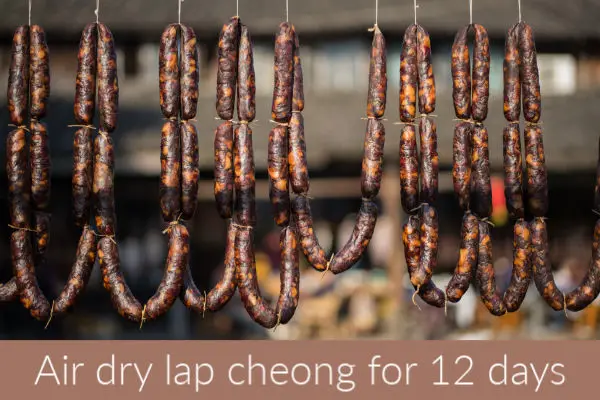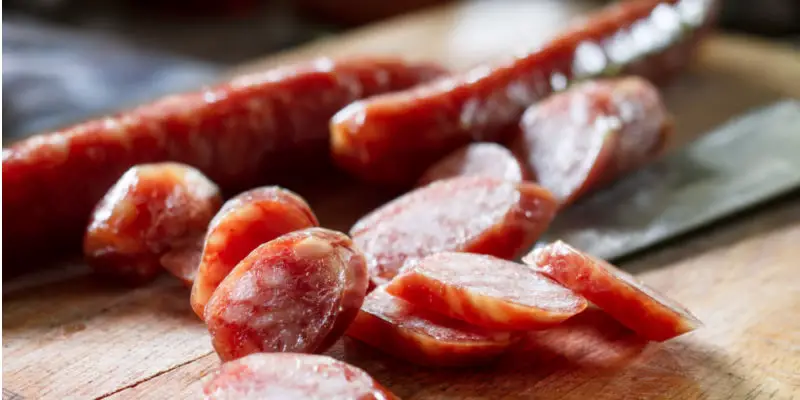Chinese sausage can look and taste different depending on which region of China the recipe originates from. A popular type of Asian sausage is lap cheong or lap chong: a thin, hard, wrinkled looking, dried sausage traditionally made from pork meat with high levels of fat. Seasoning is added to provide a sweet flavor to the meat that is unique to sausages made in other parts of the world.
Did you know? Lap cheong was one of the first sausages invented, back in 580 BC. Read more about who invented the sausage here.
Lap cheong is a sweet and salty tasting sausage that has pockets of fat that help to highlight the flavors and enhance the fatty texture. During cooking the fat melts but is often still trapped in the meat, creating mini-explosions of umami flavor.
How to make lap cheong
Lap Cheong can be translated to mean “winter stuffed intestine”. In China it’s usually made in Winter when the temperature is cool and humidity isn’t too high. These are the best conditions for drying the sausage. If you live in the United States or some other part of the world then the middle of winter may not be appropriate. Instead use the following as a guideline:
Optimum drying conditions: 10-12º C (50-53º F) and 65% humidity.
Of course, if you have a drying room or basement that maintains a consistent temperature all year round then get started any time!
Makes: 50 sausages (8” long).
Ingredients
- 8 lb lean pork
- 3 lb pork back fat
- 2 Tbsp curing salt
- 10 Tbsp rock salt
- ½ cup soy sauce
- ¼ cup rose wine
- 1 Tbsp pepper
- 3 ½ tsp cinnamon
- 10 oz sugar
- 10 feet sausage casings (natural or synthetic)
Method
- Chop pork into 2” pieces and feed through a meat grinder using a ¼” plate.
- In a large bowl combine pork with cure, salt, soy sauce, rose wine, pepper, cinnamon and sugar. Leave overnight in fridge to allow the meat to begin curing.
- Using a sausage stuffer, feed the meat mixture into the chute and fill sausage casings. As each casing is filled, create 8” sausages by twisting them at the appropriate place and tying with twine or cotton.
- Fill a large bowl with water and gently clean the sausages then brush with Chinese Baiju or any other hard liquor. This will help to sterilize the lap cheong.
- Dry the links with a clean tea towel then hang to dry for 10-12 days in cool wind. If you’re in a warmer climate hang in a room that is cool and gets a little breeze.
- After 12 days place in an airtight container or wrap in plastic cling film and store frozen. Your sausage should last up to 6 months.

Air drying allows the sausage to last many months before going off.
Alternative spices you can add
If you are looking to add more flavors to your meat then the following all work well. Experiment with seasoning and consider cooking a tablespoon of the meat mixture before stuffing it. This will allow you to taste test the flavor and make alterations as needed.
- Fennel
- Ginger
- Nutmeg
- Sichuan pepper
- Galangal
- Cardamom
- 5 spice powder
Tips for making lap cheong
- The majority of lap cheong manufacturers in China use MSG to help intensify the savory flavor. To make homemade sausage taste closer to the store bought one: add MSG at a ratio of 0.5% of the total recipe ingredients.
- A smokehouse can be used to dry the sausages but avoid using smoke.
- If storing dried lap cheong in the fridge, run under hot water briefly to make slicing easier.
Cooking Chinese sausage
In China, Lap cheong is commonly cooked in the same pot as the rice is being cooked in. This allows the delicious flavors from the sausage to filter through every grain of rice.
Other options for cooking lap cheong include using as a filling in dumplings and Bao steamed buns, stir fried with chili ginger and garlic or simply grilled on skewers.



Leave A Comment